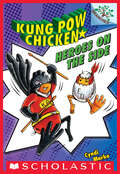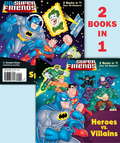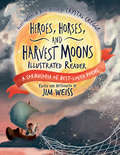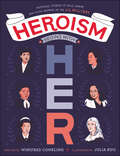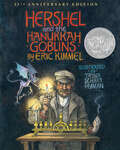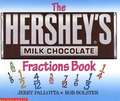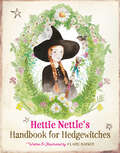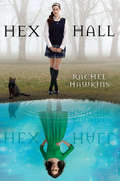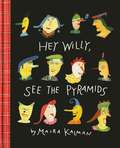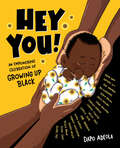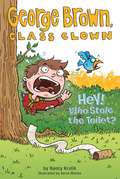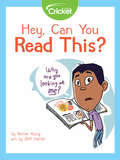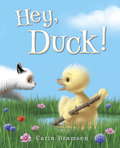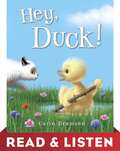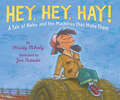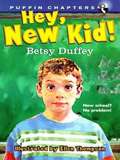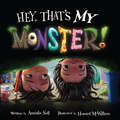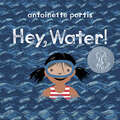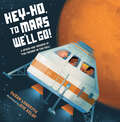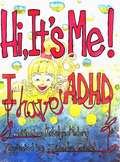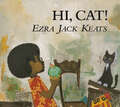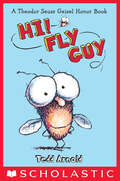- Table View
- List View
Heroes of the Surf
by Elisa CarboneAdventure on the high seas! WHAM! The Pliny jolts as if Black Beard himself has just punched her in the belly. Pedro and I slide and smack--bang--into the bulwark. "We're grounded," cries the first mate. "We've hit a shoal!" In May of 1882, a large steamship ran aground off the coast of New Jersey. Elisa Carbone imagines what it was like for two boys on that ship: waking up in the middle of the night, waves crashing over the side, the storm too big to lower the lifeboats. And then the flashing of light from shore--the surfmen, true "heroes of the surf," come to rescue them. The award-winning author's meticulous research combined with Nancy Carpenter's spectacular illustrations make this thrilling adventure on the high seas one not to be missed!
Heroes on the Side (Kung Pow Chicken #4)
by Cyndi MarkoEveryone’s favorite avian superhero must rescue the world’s sidekicks from a dastardly chicknapper in this action-packed, illustrated chapter book.Gordon Blue and his brother Benny are taking a trip to New York City. That means superhero Kung Pow Chicken and his sidekick, Egg Drop, will be there! Egg Drop gets invited to a big sidekicks party. But it is a trap! Bad guy Ticklebeak and his Bad Eggs chicknap all of the world’s sidekicks! Can Kung Pow Chicken save the sidekicks? Or will this hero crack under pressure?Praise for Let’s Get Cracking!“A perfectly puntastic page-turner. Hybrids of comics and traditional pictures, the goofy all-color illustrations propel the fast-moving, high-interest story. ‘Ham and eggs’—you don’t want to miss this!” —Kirkus Reviews, starred review “Just the thing for beginning readers.” —Publishers Weekly“Step aside, Captain Underpants! There is a new hero in town—this time, with feathers. . . . Fresh, funny, and packed with full-color illustrations, this new transitional series will be an instant hit with readers looking for silly fun and a touch of mystery.” —Booklist
Heroes vs. Villains/Space Chase! (Pictureback(R))
by Billy Wrecks Erik Doescher Mike Decarlo David D. TanguayIt's two DC Super Friends storybooks in one--plus over 50 action-packed stickers! On one side, boys ages 3-7 will be introduced to Batman, Superman, and all the Super Friends' amazing powers and most notorious villains. Flip the book over for an action-packed story featuring the Super Friends flying into outer space to stop the Joker when he takes over a satellite and broadcasts his bad jokes all over the planet!
Heroes, Horses, and Harvest Moons Illustrated Reader: A Cornucopia Of Best-loved Poems (A Cornucopia of Best-Loved Poems #0)
by Jim Weiss Crystal CreggeClassic poems about nature, bravery, love, and the wild journeys of the imagination, beautifully illustrated by Crystal Cregge.
Heroism Begins with Her: Inspiring Stories of Bold, Brave, and Gutsy Women in the U.S. Military
by Winifred ConklingFor fans of Rad American Women A–Z, Rebel Girls, and Women Who Dared comes an inspiring collection of more than 80 profiles about the brave women in the US military who fought hard for their country and even harder for what they believed in.From the Revolutionary War to present day, women have proudly served in the United States Army, Navy, Air Force, Marines, and Coast Guard as nurses, pilots, engineers, soldiers, and more. They dressed as men, worked for little pay and no benefits, and endured prejudice to break down barriers and earn their place beside their fellow servicemen. The achievements and courageous acts of these women forever changed the way the military operates!From well-known women to unsung heroes, this beautifully illustrated book tells incredible, captivating tales of gutsy women like Margaret Corbin, Harriet Tubman, Tammy Duckworth, and countless others.And it will prove just one thing: Women really can do anything!
Hershel and the Hanukkah Goblins: 25th Anniversary Edition
by Eric A. KimmelThe classic Hanukkah tale, shared by families all around the world-- now available in a beautiful anniversary edition. A Caldecott Honor book. An original tale featuring a traditional Jewish folk hero, this clever story, which received a Sydney Taylor Honor, has been a family favorite for decades. On the first night of Hanukkah, a weary traveler named Hershel of Ostropol eagerly approaches a village, where plenty of latkes and merriment should warm him. But when he arrives not a single candle is lit. A band of frightful goblins has taken over the synagogue, and the villagers cannot celebrate at all! Hershel vows to help them. Using his wits, the clever trickster faces down one goblin after the next, night after night. But can one man alone save Hanukkah and live to tell the tale? Trina Schart Hyman&’s leering goblins are equal parts terrifying and ridiculous as they match wits with Hershel, trying to keep him from lighting the menorah and celebrating Hanukkah. This beautiful 25th Anniversary Edition includes an insightful afterword from the author and publisher explaining the book's origins, and remembering Trina Schart Hyman, the illustrator who brought the tale to life. This classic picture book is a perfect Hanukkah gift and a wonderful read-aloud. For more tales of this clever folk hero, read The Adventures of Hershel of Ostropol— another collaboration between master storyteller Eric A. Kimmel and Trina Schart Hyman. Caldecott Honor Book ALA Notable Children&’s Book NCTE Notable Children&’s Book in the Language Arts A Sydney Taylor Award Honor Book Colorado Children&’s Book Award Washington Children's Choice Picture Book Award
Hershey's Milk Chocolate Fractions Book
by Jerry Pallotta Rob BolsterA Hershey's bar is made up of 12 little rectangles, making it the perfect edible tool for teaching fractions!
Hettie Nettle's Handbook for Hedgewitches
by Claire BarkerWherever there's a patch of nature, children can find the Wild Wood, and wherever there is the Wild Wood, a little hedgewitch is needed! Hettie&’s Nettle&’s month-by-month guide opens the door on a hidden world – one that only children can see. Full of secrets, top tips and funny, magical friends, this handbook is an essential guide for imaginative young guardians of nature. • Learn each month's secret Whisper Name (January's is The Dreaming – shh!)• Enjoy celebrity interviews with celebrities from the Wild Wood (such the Sun and Jack Frost)• Help organize the seasonal celebrations of the Wheel of the Year (the wedding of Jack-in-the-Green and the Queen of the May at Beltane is the event of the season!)• Have fun with the Spell of the Month (make a wish with a dandelion clock charm)• Enjoy seasonal tales from Flittermouse (Hettie's favourite is The Hare and the Moon!)Filled with watercolour illustrations from Hettie&’s enchanted paintbox and details about the fascinating folk she meets in her daily life, this secret notebook will connect you with the magic that lives inside and around us every day.
Hettie Nettle's Handbook for Hedgewitches
by Claire BarkerWherever there's a patch of nature, children can find the Wild Wood, and wherever there is the Wild Wood, a little hedgewitch is needed! Hettie&’s Nettle&’s month-by-month guide opens the door on a hidden world—one that only children can see. Full of secrets, top tips, and funny, magical friends, this handbook is an essential guide for imaginative young guardians of nature. • Learn each month's secret Whisper Name (January's is The Dreaming—shh!)• Enjoy celebrity interviews with celebrities from the Wild Wood (such the Sun and Jack Frost)• Help organize the seasonal celebrations of the Wheel of the Year (the wedding of Jack-in-the-Green and the Queen of the May at Beltane is the event of the season!)• Have fun with the Spell of the Month (make a wish with a dandelion clock charm)• Enjoy seasonal tales from Flittermouse (Hettie's favourite is The Hare and the Moon!)Filled with watercolor illustrations from Hettie&’s enchanted paintbox and details about the fascinating folk she meets in her daily life, this secret notebook will connect you with the magic that lives inside and around us every day.
Hex Hall: To Be Recycled - Duplicate Isbn (A Hex Hall Novel #1)
by Rachel HawkinsThree years ago, Sophie Mercer discovered that she was a witch. It's gotten her into a few scrapes. Her non-gifted mother has been as supportive as possible, consulting Sophie's estranged father???an elusive European warlock???only when necessary. But when Sophie attracts too much human attention for a prom-night spell gone horribly wrong, it's her dad who decides her punishment: exile to Hex Hall, an isolated reform school for wayward Prodigium, a.k.a. witches, faeries, and shapeshifters.
Hey Willy, See the Pyramids
by Maira KalmanNighttime is the best time for stories. And Lulu is the best storyteller. She knows about the three cross-eyed dogs at a fancy restaurant, about blue and green mountains where fish fly, about the family party where Maishel Shmelkin forgot to wear his pants and of course about the noodle woman the pointy red nose. The stories, told by a sister to her little brother, are short and sweet and make you remember things and forget things. Maira Kalman paints a wondrous and humor-filled world in a childs-eye view. It is full of wild invention, people familar and outlandish, bittersweet moments and flights of fancy.
Hey You!: An Empowering Celebration of Growing Up Black
by Dapo AdeolaThis remarkable picture book is a lyrical, inspirational exploration of growing up Black, written by award-winning illustrator Dapo Adeola, and brought to life by some of the most exciting Black artists of today.Remember to dream your own dreams Love your beautiful skin You always have a choice This book addresses--honestly, yet hopefully--the experiences Black children face growing up with systemic racism, as well as providing hope for the future and delivering a message of empowerment to a new generation of dreamers. It's a message that is both urgent and timeless--and offers a rich and rewarding reading experience for every child. To mirror the rich variety of the Black diaspora, this book showcases artwork from Dapo Adeola and eighteen more incredible Black illustrators in one remarkable and cohesive reading experience.
Hey! Who Stole the Toilet? #8
by Nancy KrulikGeorge goes WILD in the wild!In the eighth book of Nancy Krulik's popular George Brown, Class Clown series, George Brown is going on his first camping trip with his scout troop. After a trial run with his dad in the backyard, George can't wait to head out into the wilderness. It doesn't take long, though, for the Super Burp to drown out the soothing sounds of babbling brooks and bird calls. Too bad there's no such thing as a bug spray for burps! .
Hey, Can You Read This?
by Rachel YoungLearn about the science behind reading and how the cerebellum, neurons, and optic nerve all work together to make words come alive.
Hey, Dog
by Tony JohnstonA boy wins over an abused, stray dog with persistence and love in this heartwarming story.Thoughtful care goes into a child's efforts to help an abused dog learn to trust humans again. Stooping near the bush where the dog is hiding, offering scraps of food, and leaving an umbrella in a rainstorm all convince the dog that the child's offering of friendship is real. When Mom insists on putting up "lost dog" signs, the boy is worried. But in the end, the dog and child find a new friend in each other.
Hey, Duck!
by Carin BramsenAn adorable little duckling is trying to befriend another "duck." However, he is oblivious to the fact that his potential pal is, in fact, a cat. Though resistant and stubborn at first, the cat soon realizes labels don't matter in the least--and before you know it, meowing and quacking are one and the same.
Hey, Duck! Read & Listen Edition
by Carin BramsenIn this charming Read & Listen ebook, an adorable little duckling is trying to befriend another "duck." However, he is oblivious to the fact that his potential pal is, in fact, a cat. Though resistant and stubborn at first, the cat soon realizes labels don't matter in the least—and before you know it, meowing and quacking are one and the same. This ebook contains Read & Listen audio narration.
Hey, Hey, Hay!
by Christy MihalyEvery bale of hay has a little bit of summer sun stored in the heart of it— learn from a mother-daughter team how hay is made! Feeding her horses one cold and wintry day, a girl thinks about all the hard work that went into the fresh-smelling bales she's using. The rhyming text and brilliant full-page paintings follow the girl and her mother through the summer as they cut, spread, dry and bale in the fields. Mower blades slice through the grass./A new row falls with every pass./Next we spread the grass to dry./The tedder makes those grasses fly! This celebration of summer, farming, and family, illustrated by Pura Belpré honor artist Joe Cepeda, includes a glossary of haymaking words, and a recipe for making your own switchel— a traditional farm drink, to cool you down in the summer heat. A Bank Street Best Children's Book of the Year
Hey, New Kid!
by Betsy Duffey Ellen ThompsonCody?s father is an F.B.I. agent, he?s got a pet emu, and he?s an ace on Rollerblades. At least, that?s what Cody tells his class on the first day at his new school. Being Super Deluxe Cody is great, until someone throws a skating party. And suddenly, the game may be up! Betsy Duffey is the author of numerous books for young readers, including How to Be Cool in the Third Grade, The Math Wiz and Utterly Yours, Booker Jones. She lives in Atlanta, Georgia. Ellen Thompson has illustrated over one hundred children?s book jackets, and her work has appeared in numerous magazines. She lives in Franklin Park, New Jersey.
Hey, That's MY Monster! (I Need My Monster)
by Amanda NollWinner:CLC Seal of Approval2017 Literary Classics Book Awards, Silver, Preschool/Early Reader FantasyFinalist:2017 Literary Classics Book Awards2017 PNBA Long-List When Ethan looks under the bed for his monster, he finds this note instead: "So long, kid. Gotta go. Someone needs me more than you do. –Gabe" How will Ethan ever get to sleep without his monster's familiar, comforting snorts? And who could need Gabe more than Ethan does? Gabe must have gone to Ethan's little sister's room! She has been climbing out of bed every night to play, and obviously needs a monster to help her get to sleep – but not HIS monster! Ethan tries to help his sister find her own monster, but none are the perfect blend of cute and creepy. Just when it seems that Ethan will lose his monster forever, an uninvited, tutu-toting little monster full of frightening fun appears. Following in the spooky-silly tradition of I Need My Monster, here's another irresistible monster-under-the-bed story with the perfect balance of giggles and shivers.
Hey, Water!
by Antoinette PortisSplash! A spunky little girl plays a spirited game of hide-and-seek with water, in this gorgeously illustrated nonfiction picture book.A Robert F. Sibert Honor BookAn ALA Notable Children's BookHey, water! I know you! You're all around.Join a young girl as she explores her surroundings and sees that water is everywhere. But water doesn't always look the same, it doesn't always feel the same, and it shows up in lots of different shapes. Water can be a lake, it can be steam, it can be a tear, or it can even be a snowman. As the girl discovers water in nature, in weather, in her home, and even inside her own body, water comes to life, and kids will find excitement and joy in water and its many forms. This latest work from award-winning author/illustrator Antoinette Portis is an engaging, aesthetically pleasing nonfiction picture book, complete with accessible backmatter on the water cycle, water conservation, and more.A School Library Journal Best Book of the YearA Bank Street Best Book of the YearSelected for the CBC Champions of Change ShowcaseA Pennsylvania Center for the Book Baker's Dozen Selection!
Hey-Ho, to Mars We'll Go!: A Space-Age Version of "The Farmer in the Dell"
by Susan LendrothPerfect for STEM and space storytimes, this musical mission to Mars will have young astronauts singing along as they learn the science of space travel.Explore the science behind a trip to Mars, from launch to landing on the Red Planet. Set to the tune of "The Farmer in the Dell," this jaunty journey follows five adorable, bobble-headed astronauts as they learn how to bathe in zero gravity, grow veggies in space, and entertain themselves on the six-month trip. Even the design of the book defies gravity, as text and art float free on the page, encouraging readers to turn the book sideways and upside-down.
Hi It's Me! I Have ADHD
by Katelyn MabryFrom thinking fast, to thinking slow, from feeling high, to feeling low; this busy child wishes adults could see inside her head. Based on the author's personal experience with Attention Deficit Hyperactive Disorder, "Hi, It's Me" shares the thoughts, feelings, emotions, and experiences of a child dealing with the many challenges of ADHD. Offering insight into the world of ADHD and presenting a list of tips and a printable coloring/journal pages; this rhyming picture book helps children struggling with ADHD feel empowered. It lets kids know that the diagnosis does NOT define them and that there are so many gifts beneath the diagnosis. It communicates that they can find peace knowing they're not alone in how they think and feel.
Hi, Cat!
by Ezra Jack KeatsOn his way to hang out with the neighborhood kids, Archie very innocently greets a stray cat who follows him and gets in the way. The cat ruins everything - Archie's street show is a mess and his audience drifts away. But things aren't all bad: when Archie goes, the cat follows him all the way home, too!
Hi, Fly Guy!: Hi, Fly Guy! (Fly Guy #1)
by Tedd ArnoldMeet Fly Guy! Is he a pest, or is he a pet?A Theodor Seuss Geisel Honor Book!"A fly was flying. He was looking for something to eat--something tasty, something slimy. A boy was walking. He was looking for something to catch--something smart, something for The Amazing Pet Show."In the first book in the NEW YORK TIMES bestselling Fly Guy series, a boy and a fly meet and form a beautiful friendship. In his signature style, Tedd Arnold delivers a fun, wacky story about a fly who's so smart that he can say a boy's name (Buzz!), win an award, and be Buzz's good friend.

